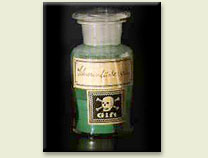How Emerald green is made:
| Artificial variety of pigment | Reaction of sodium arsenite with copper(II)-acetate. |
| 19th century recipe | Dissolve in a small quantity of hot water, 6 parts of sulphate of copper; in another part, boil 6 parts of oxide of arsenic with 8 parts of potash, until it throws out no more carbonic acid; mix by degrees this hot solution with the first, agitating continually until the effervescence has entirely ceased; these then form a precipitate of a dirty greenish yellow, very abundant; add to it about 3 parts of acetic acid, or such a quantity that there may be a slight excess perceptible to the smell after the mixture; by degrees the precipitate diminishes the bulk, and in a few hours there deposes spontaneously at the bottom of the liquor entirely discolored, a powder of a contexture slightly crystalline, and of a very beautiful green; afterwards the floating liquor is separated. |
The ground pigment:
Pile of ground Emerald green
Bottle of (poisonous) Emerld Green

(Source: Deutsches Museum, Munich)
Other greens
(intro) - Cobalt green - Copper resinate - Emerald green - Green earth - Malachite - Verdigris - Viridian
(intro) - Cobalt green - Copper resinate - Emerald green - Green earth - Malachite - Verdigris - Viridian

